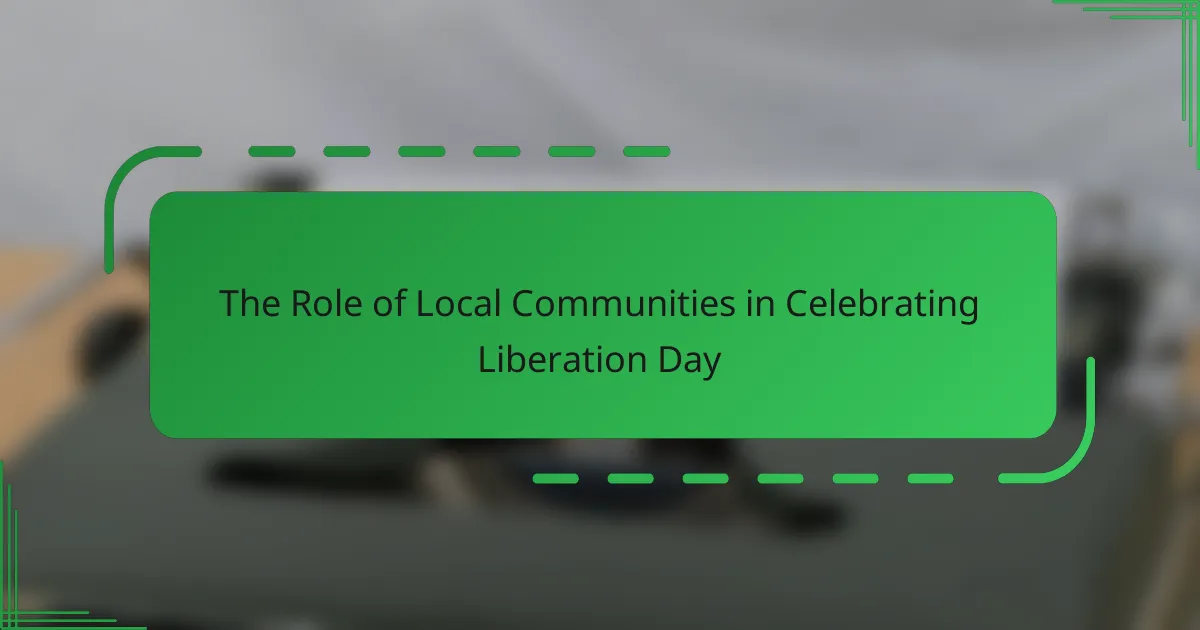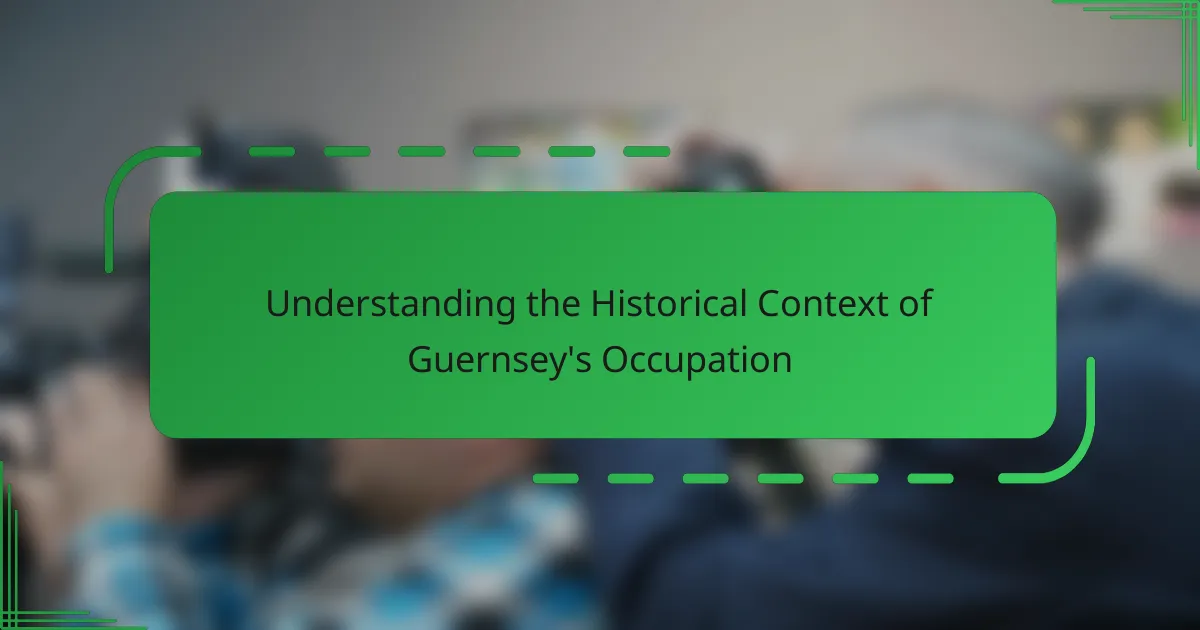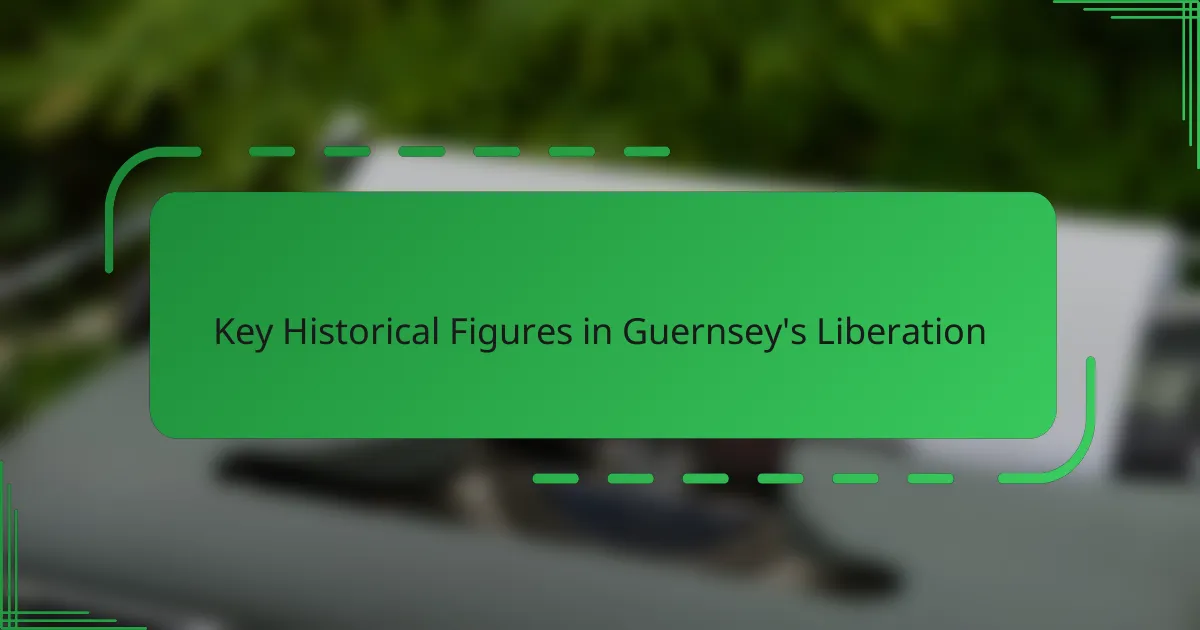Local communities play a vital role in celebrating Liberation Day, engaging in activities that promote unity and pride. Through parades, cultural performances, and food festivals, these celebrations not only honor the significance of liberation but also strengthen community bonds and reflect local heritage.
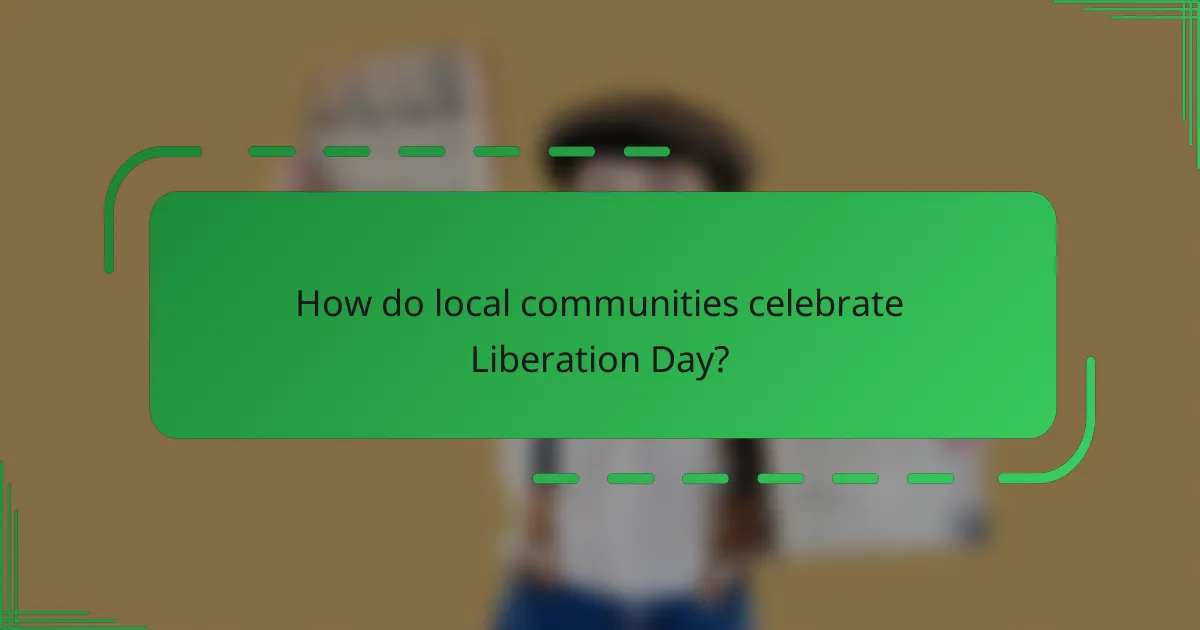
How do local communities celebrate Liberation Day?
Local communities celebrate Liberation Day through various engaging activities that foster unity and pride. These celebrations often include parades, speeches, cultural performances, food festivals, and art exhibitions, each contributing to the overall spirit of liberation and remembrance.
Community parades
Community parades are a vibrant highlight of Liberation Day celebrations, featuring colorful floats, marching bands, and local organizations. Participants often dress in traditional attire, showcasing cultural heritage and pride. These parades typically take place in city centers, attracting large crowds and fostering a sense of community.
To organize a successful parade, communities should consider logistics such as route planning, permits, and safety measures. Engaging local schools and organizations can enhance participation and create a festive atmosphere.
Public speeches
Public speeches during Liberation Day serve to honor historical figures and recount the significance of the day. Local leaders, veterans, and community members often share personal stories and reflections that resonate with attendees. These speeches aim to inspire unity and remind participants of the values of freedom and resilience.
When planning speeches, it’s important to keep them concise and impactful, ideally lasting no more than 10-15 minutes. Including a mix of personal anecdotes and historical context can make the messages more relatable and memorable.
Cultural performances
Cultural performances are a key aspect of Liberation Day, showcasing local talent through music, dance, and theater. These performances often reflect the community’s history and traditions, engaging audiences of all ages. Local artists and schools frequently collaborate to present a diverse range of acts.
Communities should aim to include performances that represent various cultural backgrounds, ensuring inclusivity. Scheduling these performances throughout the day can keep the energy high and encourage more attendees to participate.
Food festivals
Food festivals on Liberation Day celebrate local cuisine and culinary traditions, offering a variety of dishes for attendees to enjoy. Local restaurants and food vendors often set up stalls, providing everything from traditional meals to modern twists on classic recipes. This not only promotes local businesses but also fosters a sense of community through shared culinary experiences.
To enhance the food festival, communities can organize cooking demonstrations or competitions, allowing attendees to learn about the dishes being served. Offering a range of options, including vegetarian and gluten-free choices, can cater to diverse dietary needs.
Art exhibitions
Art exhibitions during Liberation Day highlight local artists and their interpretations of freedom and identity. These exhibitions can take place in community centers, galleries, or public spaces, making art accessible to all. They often feature a mix of visual arts, photography, and installations that provoke thought and discussion.
Communities should consider partnering with local artists and schools to curate exhibitions that reflect the spirit of liberation. Hosting workshops or interactive sessions can further engage the public and encourage participation in the arts.
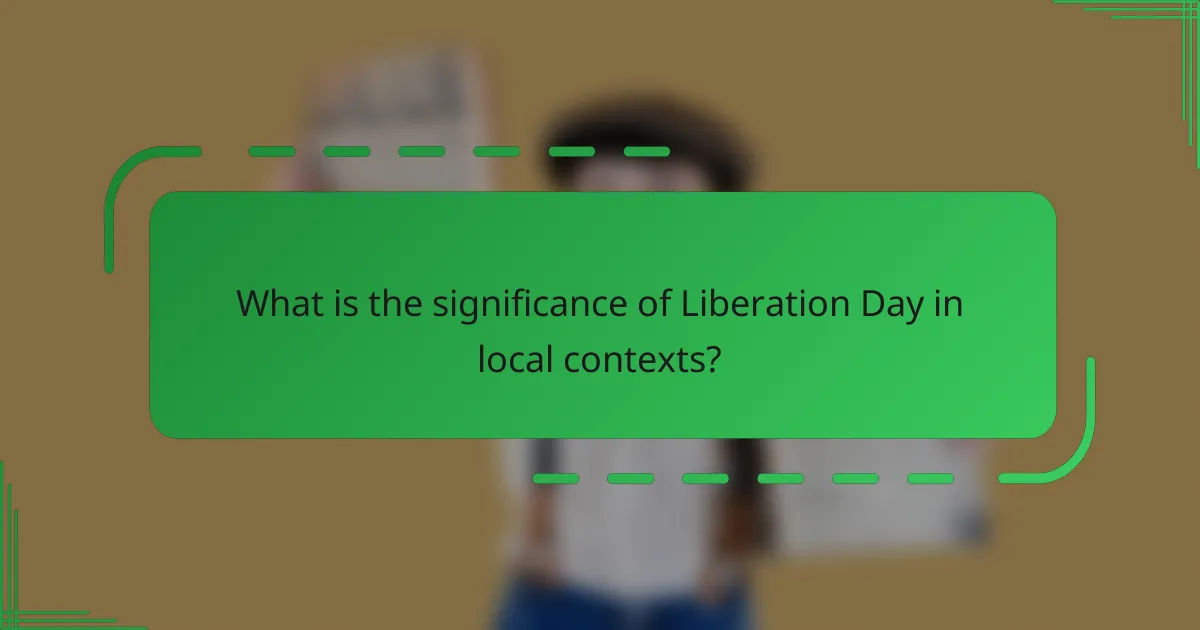
What is the significance of Liberation Day in local contexts?
Liberation Day holds deep significance in various local contexts as it commemorates the end of oppression and the beginning of freedom. This day serves as a reminder of the struggles faced by communities and the triumphs achieved in their pursuit of autonomy.
Historical importance
The historical importance of Liberation Day is rooted in the events that led to a community’s freedom from colonial or oppressive rule. It marks pivotal moments in history where sacrifices were made for the sake of liberty. Many localities celebrate this day to honor those who fought for their rights and to reflect on the lessons learned from their past.
For instance, in countries like Bulgaria, Liberation Day is celebrated on March 3rd, recognizing the liberation from Ottoman rule in 1878. Such historical milestones are crucial for fostering a sense of identity and continuity within communities.
Symbol of freedom
Liberation Day acts as a powerful symbol of freedom, representing the values of independence and self-determination. It serves as a reminder that freedom is not merely a state but a continuous effort that requires vigilance and commitment from all members of society.
Communities often use this day to showcase their cultural heritage and national pride through parades, speeches, and various festivities. These celebrations reinforce the idea that freedom is a collective achievement, deserving of recognition and appreciation.
Community unity
The celebration of Liberation Day fosters community unity by bringing people together to honor their shared history and aspirations. This day encourages participation from diverse groups, promoting inclusivity and solidarity among residents.
Activities such as community gatherings, educational programs, and local events are organized to engage citizens of all ages. These initiatives not only strengthen social bonds but also cultivate a sense of belonging and collective responsibility towards preserving freedom for future generations.
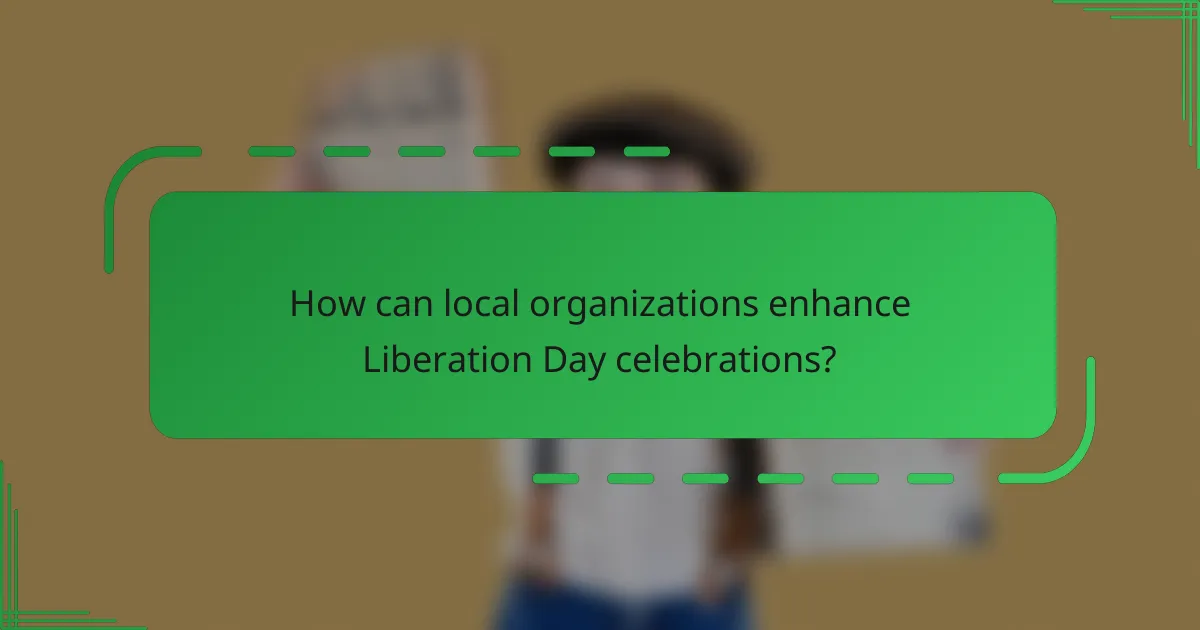
How can local organizations enhance Liberation Day celebrations?
Local organizations play a crucial role in enhancing Liberation Day celebrations by fostering community engagement and creating memorable events. They can coordinate activities that reflect local culture and history, ensuring a more inclusive and vibrant celebration.
Collaborative events
Collaborative events bring together various community groups, businesses, and residents to create a unified celebration. These can include parades, cultural performances, and educational workshops that highlight the significance of Liberation Day. By pooling resources and talents, organizations can offer a richer experience for attendees.
For example, a local arts group might partner with schools to host a mural painting event that depicts the history of liberation, allowing participants to contribute creatively while learning about their heritage.
Funding opportunities
Securing funding is essential for organizing successful Liberation Day celebrations. Local organizations can explore grants from government bodies, private foundations, or community funds specifically aimed at cultural events. These financial resources can cover costs such as permits, materials, and promotional efforts.
Additionally, organizations can consider crowdfunding campaigns or sponsorships from local businesses to enhance their budget. Engaging the community in fundraising can also build excitement and ownership of the event.
Volunteer programs
Volunteer programs are vital for the success of Liberation Day celebrations, as they provide the manpower needed to execute various activities. Local organizations can recruit volunteers from schools, community centers, and civic groups, offering them opportunities to contribute to the event while gaining valuable experience.
Organizing volunteer training sessions can help ensure that participants are well-prepared for their roles, whether they are managing logistics, assisting with activities, or providing information to attendees. This not only enhances the event but also fosters a sense of community pride and involvement.
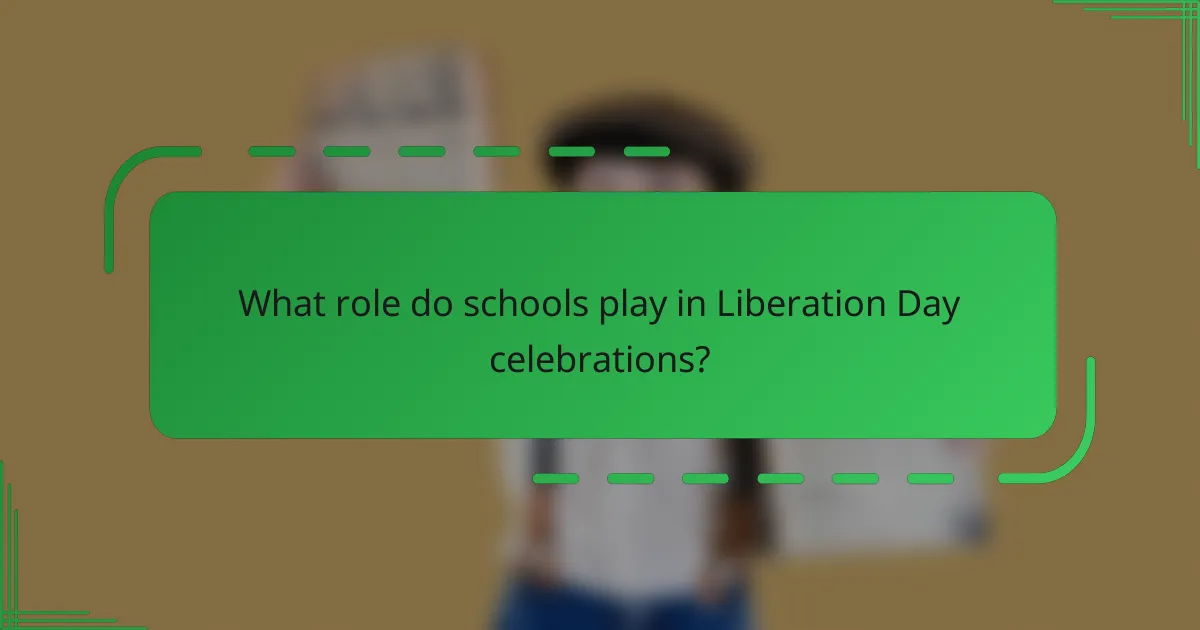
What role do schools play in Liberation Day celebrations?
Schools play a crucial role in Liberation Day celebrations by fostering a sense of community and national pride among students. They organize various activities that educate students about the historical significance of the day and encourage active participation in local events.
Educational programs
Educational programs in schools often include lessons on the history and significance of Liberation Day. These programs may involve interactive workshops, guest speakers, and multimedia presentations that engage students and deepen their understanding of the event’s importance.
Schools may also incorporate art and literature into their curriculum, allowing students to express their thoughts and feelings about liberation through creative projects. This approach not only enhances learning but also promotes critical thinking and emotional connection to the subject matter.
Student-led initiatives
Student-led initiatives are vital for empowering young people to take ownership of Liberation Day celebrations. Schools can encourage students to form committees that plan and execute events, such as parades, performances, or cultural exhibitions, which highlight local traditions and history.
These initiatives foster leadership skills and teamwork, as students collaborate to create meaningful experiences for their peers and the community. Schools should provide guidance and resources to support these efforts, ensuring that students feel confident in their roles.
Community service projects
Community service projects are an excellent way for schools to engage students in Liberation Day celebrations while giving back to the community. Schools can organize activities such as clean-up drives, food drives, or volunteering at local shelters, linking the spirit of liberation to acts of service.
Participating in community service not only reinforces the values of unity and cooperation but also helps students develop a sense of responsibility and empathy. Schools should encourage students to reflect on their experiences and share how these projects connect to the broader themes of Liberation Day.
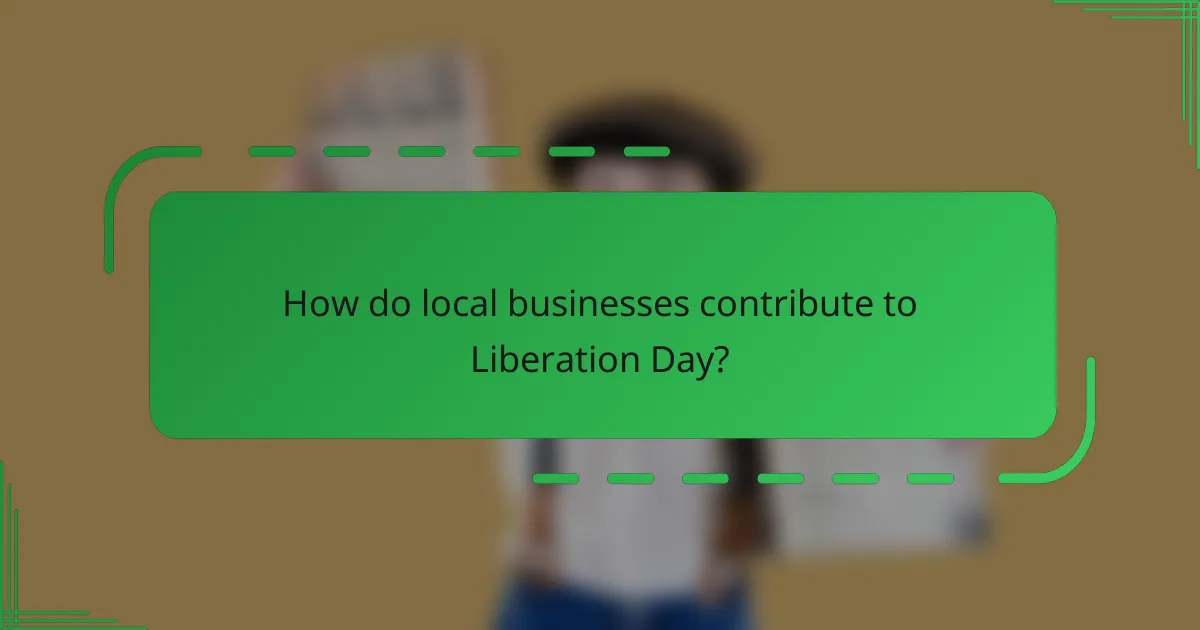
How do local businesses contribute to Liberation Day?
Local businesses play a vital role in celebrating Liberation Day by sponsoring events, engaging in promotional activities, and fostering community involvement. Their contributions help create a vibrant atmosphere that honors the significance of the day while boosting local economies.
Sponsorship of events
Local businesses often sponsor various events during Liberation Day, such as parades, concerts, and cultural festivals. This sponsorship can include financial support, providing venues, or donating goods and services, which enhances the overall experience for attendees.
For example, a local restaurant might sponsor a food festival, offering free samples or discounts to visitors. Such initiatives not only promote the business but also enrich the community’s celebration.
Promotional activities
Many local businesses engage in promotional activities to attract customers during Liberation Day. This can include special discounts, themed merchandise, or limited-time offers that resonate with the holiday’s spirit.
Businesses might create Liberation Day-themed marketing campaigns, utilizing social media and local advertising to reach a broader audience. These promotions can significantly increase foot traffic and sales, benefiting both the business and the community.
Community engagement
Community engagement is essential for local businesses during Liberation Day, as they often participate in or organize activities that bring people together. This can involve hosting workshops, sponsoring local artists, or participating in community service projects.
By actively engaging with the community, businesses can build stronger relationships with customers and demonstrate their commitment to local culture. This not only enhances the celebration but also fosters loyalty among patrons, creating a supportive local economy.

What are the challenges faced by communities during Liberation Day?
Communities often encounter several challenges when celebrating Liberation Day, including funding limitations, logistical issues, and the need for community engagement. These obstacles can hinder the overall effectiveness and inclusivity of the celebrations.
Funding limitations
Funding limitations are a significant challenge for communities organizing Liberation Day events. Many local organizations rely on donations, sponsorships, or government grants, which may not always be sufficient to cover expenses such as permits, decorations, and activities.
To address funding limitations, communities can explore various strategies. They might consider crowdfunding campaigns, partnerships with local businesses, or applying for grants specifically aimed at cultural celebrations. Engaging the community in fundraising efforts can also foster a sense of ownership and investment in the event.
It’s crucial for organizers to create a detailed budget that outlines all potential costs and identifies funding sources. This approach helps ensure that celebrations are not only memorable but also financially sustainable, allowing for future events to thrive.
